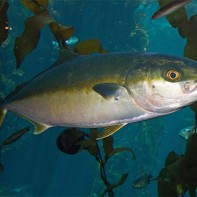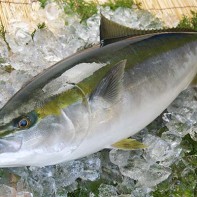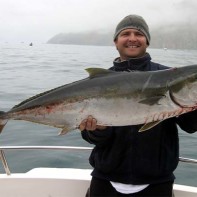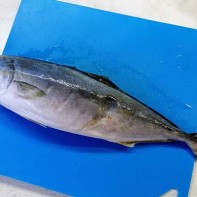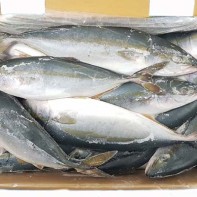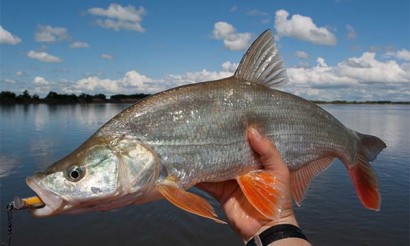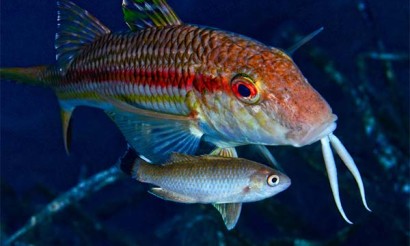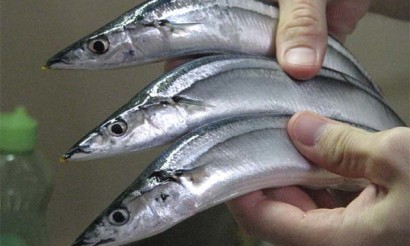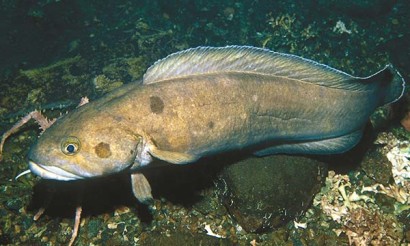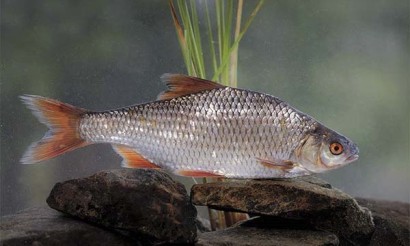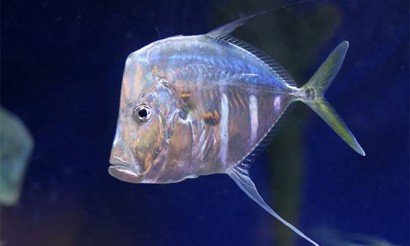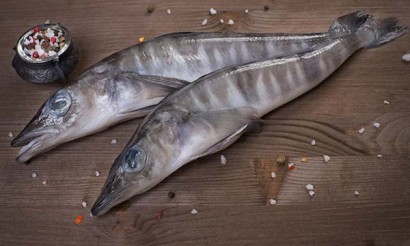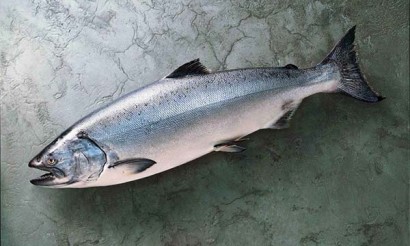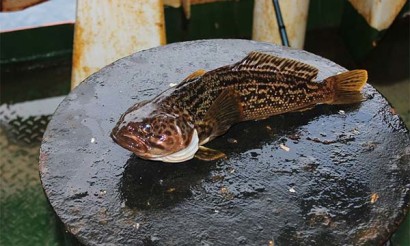Lakedra (yellowtail): description of the fish, useful properties and recipes
Well familiar to the Japanese, Koreans yellowtail is considered a symbol of good luck. It is easy to clean, thanks to the increased fat content does not stick to the pan when frying, to the foil when baking. Delicate fish decorates the table on holidays and weekdays, strengthens the immune system, slows aging.
- Lakedra: what kind of fish it is, how it looks and where it lives
- How it looks
- Where does it live?
- What does it eat?
- Natural Enemies
- Reproduction and life span
- Variety
- How it differs from the tuna
- How to catch yellowtail: when, where and on what?
- When to catch
- Where to catch
- What to catch
- Composition and calories
- How is the meat of the yellowtail lakedra useful?
- Harms and contraindications
- How to choose and store
- Where to buy and how much costs
- How to cook lakedra fish very well: Recipes
- In the oven
- In the frying pan
- In a multicooker
- On the barbecue or grill
- Recipe for yellowtail soup
- How to salt sea laker
- Q&A
- What does a ruddetail taste like?
- Fatty or not?
- Are there many bones in the fish?
- Interesting facts
Lakedra: what kind of fish it is, how it looks and where it lives
The yellowtail lakedra Seriola quinqueradiata belongs to the family Stavrididae genus Seriola. Trophy specimens of fish, similar in appearance to the tuna, grow up to one and a half meters and weigh 40 kg. The average weight of a commercial fish is 1 kg and its body length is 30-40 cm. During long food migrations, yellowtail often accompanies large shoals of anchovy, sardine, and cavassi. The fish go to the southern borders of their range for wintering.

What does it look like?
Japanese lakedra has an elongated torpedo-shaped body with a pointed conical head. The first short dorsal fin consists of barbed rays, long, reaching to the tail the second - from the soft.
The lead-blue coloration of the back is lighter as it gets closer to the belly. Narrow yellow stripes run from the pointed snout through the eyes along the body to the bifurcated tail fin. The smooth skin is covered with fine, silvery scales that reflect light well. The color of the fins - yellowish.
Where does it live
Pelagic fish that lives in the water column, found massively off the coast of East Asia. Commercially it is caught in Korea, Japan, Taiwan, China.
In Russia, it is common in the south of the Kuril Islands, Sakhalin, and Primorsky Krai.
The largest population breeds in the East China Sea, from where the fry head for Hokkaido Island, where they spend the first years of their lives. In summer, they migrate further north into Russian territorial waters and return in winter.
What does it eat?
Lakedras by food behavior hunt in a pack, surrounding a school of fish, squeezing it into a cauldron. At this time, you can observe the bubbling surface, the fish jumping out of the water. Yellowtail is indiscriminate in food, swallowing anything edible that comes across the way. Most of its prey - fry, small fish, roe, mollusks.
The lakedra's diet includes:
Young yellowtail are content with zooplankton, and as they mature they are increasingly displaced by fish.
In aquaculture farms in the artificial cultivation lakedra are fed with minced meat of particulate species or fish meal.
Natural enemies
Sharks, of which there are many in the southern seas of the Pacific Basin, pose a threat to large, sexually mature specimens. Seabirds and other species of predatory fish, including lakers themselves, prey on juvenile and spawned yellowtail.
Reproduction and life span
Representatives of the species become sexually mature in their third year of life. Annual spawning migrations begin in May. The fish head for the coasts of South Korea and the Japanese islands of Shikoku and Kyushu.
Spawning in the two-hundred-meter coastal zone occurs in portions and may last until the end of summer, depending on weather conditions. During the spawning period, females release several tens of thousands of small pelagic eggs less than 1 mm in diameter. They are immediately fertilized by males swimming nearby.
The parents do not care about their offspring. The eggs are left to chance. They are carried long distances by the currents. Some of the eggs remain unfertilized, die or are eaten by predatory fish. The larvae do not hatch from the remaining eggs until 4 months later.
They grow quickly, feeding on coastal plankton and sheltering among the kelp. From the first days of their existence, the fry look very similar to the adults and show predatory habits. The young fish eat eggs, small crustaceans and fry, moving farther and farther from the shore to the northern boundaries of their habitat.
The Japanese on Shikoku Island were the first to master artificial breeding of the rudders. Multigrade yellowtail caught in the sea were released in a fenced enclosure in 1927, but the first batch of captive-bred fish breeders have put on the market only in 1940. By trial and error, the Japanese picked up the appropriate food, worked out the optimal conditions for maintenance, through which the Lakedra began to gain marketable weight for the year. Among wild fish trophy specimens emerge at the age of two years.
Longevity of yellowtail is 12 years, and some long-livers have a life expectancy of 15 years.
Varieties
Seriola species differ from each other in appearance, places of distribution:
- Seriola carpenteri or Guinea amberjack grows up to 0.5 meters. It is found in the waters of the African coast, the central Mediterranean.
- Long-finned yellowtail with flattened body and sickle-shaped fins lives in the eastern Pacific. Maximum body length - 1.6 m, weight - 60 kg.
- The striped paddlefish or rudderfish is sexually colored blue, greenish or brown. Vertical black stripes are characteristic of juveniles. Seriola zonata is caught in the western Atlantic Ocean.
- Seriola peruana is distributed from Mexico to Ecuador to the Galapagos Islands. Bentopelagic fish live at depths of up to 30 meters.
- The great yellowtail is the largest species in the family Stavrididae. Its maximum weight is 80 kg with a body length of 1.9 m. The species inhabits subtropical, tropical seas of the world's oceans. Distinctive features include a diagonal black stripe, black fins on a silvery-blue body.
- The small amberjack with olive back and silvery sides lives in the western, eastern Atlantic, Caribbean Sea, near Bermuda at depths of 50-130 m.
- Yellowtail kingfish are common in the seas of the southern hemisphere, in the northern Pacific, in the rocky reefs of Australia.
- Samsonfish up to a meter and a half long are found in the northern part of Australia.
How it differs from tuna
Unscrupulous sellers often pass off the lakedra as tunaAlthough the external differences are obvious. Yellowtail has a torpedo-like body with smooth transitions. The tuna body has a round cross-section spindle-shaped, sharply tapering to the caudal stem.
A characteristic feature of the tuna is the sickle-shaped fins (anal and second dorsal). Lakedra is distinguished by a yellow stripe running from the snout to the tail.
The tuna lives in the Atlantic Ocean, the Japanese yellowtail in the Pacific. Taxonomy also differs. The first species is a member of the Mackerel family, the second belongs to the Stavrid family.
How to catch yellowtail: when, where and on what?
Strong fast lakedra makes sharp maneuvers, stubbornly resists on the pulling. This is what makes it interesting to amateur anglers. Common types of fishing - by spinning, trolling from a motorboat or boat.
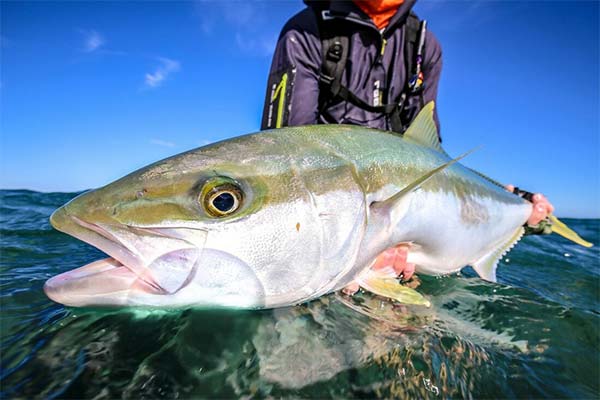
When to fish
In Japanese waters, yellowtail is most active in late April, early May. By this time, the water gets warmer than 14 degrees, predators rush to the shore for shoals of anchovy and snapper. When the water temperature rises above 22 degrees, the fish become less active and head north.
In Primorye, the laker is caught from June to September. In July and August anchovies come to the coastal area for spawning, and in July and October the sprat. August is a good month for fishing on Sakhalin.
Where to fish
To avoid wasting time casting baits, the fishing locations are chosen according to the gulls. The birds usually circle over the cauldron, formed by a flock of yellowtail, surrounding a school of smaller fish.
Recreational fishing of the rudders is common in Primorye and, to a lesser extent, on Sakhalin. Trophy specimens are caught more often in Japan and Korea.
What to fish with
For trolling use specialized blanks of fiberglass with powerful hardware. Reels - multiplier, as large as possible with monofilament with a diameter of up to 4 mm.
For fishing on spinning with the throwing rod is needed with a relatively soft tip length of 2,3-2,5 m with a test weight corresponding to the weight of the bait. The reel can be wineless or multiplier, but always with a reliable brake, protection from salt water. The braided cord is nylon of PE5 class.
For jigging buy a lightweight spinning rod from Japanese manufacturers of length 1,7-1,9 m, weight 250 g with a parabolic string, flurocarbon cord class PE4, jig extended in length.
Japanese laker is caught on fresh shrimp, squid, pole tackle in the plumb line, popularly known as samodur, stickbaits (wobblers without a blade), silicone imitations, pelker, spinner.
Composition and calories
In significant quantities lakedra includes B vitamins, nicotinic acid, phosphorus, potassium, selenium, manganese and fatty acids.
Contents in 100 g of yellowtail vitamins, minerals:
Vitamins:
- Cobalamin - 0.002 mg;
- Nicotinic acid - 7 mg;
- Riboflavin - 0.4 mg;
- Pantothenic acid - 0.6 mg;
- Thiamine - 0.1 mg;
- Pyridoxine - 0.2 mg;
- A - 0.03 mg;
- C - 0.003 mg;
- Folates, 0.004 mg.
Macronutrients:
- Phosphorus - 157 mg;
- Potassium - 420 mg;
- Magnesium - 30 mg;
- Sodium - 39 mg;
- Calcium - 23 mg.
Micronutrients:
- Selenium - 0.04 mg;
- Manganese - 0.2 mg;
- Zinc - 0.5 mg;
- Iron - 0.5 mg;
- Copper - 0,001 mg.
Fat content of 100 grams of the product - 21, 16, 0 g, respectively. The energy content is 240 kcal.
How is the meat of the yellowtail lakedra useful?
Antioxidants in the composition of yellowtail support the health of cells. They bind, remove free radicals, protect the integrity of membranes from external influences, and repair damaged ones.

Other beneficial effects of lacedra:
- Increases immune status, the body's resistance to colds.
- Improves the twilight adaptation of the organs of vision, the susceptibility of the color palette of the visual analyzer.
- Supports the health, youthfulness of the skin, mucous membranes.
- Participates in hematopoiesis, the synthesis of hemoglobin, hormones.
- Speeds up lipid, carbohydrate metabolism, absorption of proteins, sugars in the intestines.
- It prevents anemia, atherosclerosis, heart failure, depression, neurosis.
- Increases fertility in women, improves the quality and activity of sperm in men.
- Builds muscle mass, which is especially important for people engaged in power sports.
- Strengthens the vascular wall, normalizes blood pressure.
- Activates the work of the brain.
- Strengthens memory, concentrates attention, quickens thinking.
- Improves digestion, peristalsis.
- Supports the work of the adrenal cortex.
- Increases stamina and performance.
- Mineralizes bones, increases the strength of the nails and tooth enamel.
- Strengthens hair follicles.
Inclusion of yellowtail meat in the diet has a positive effect on the function of the urogenital and nervous system. Fish is useful for the older generation, as it inhibits the development of dementia, Alzheimer's and Parkinson's disease.
Harms and contraindications
Lakedra is contraindicated in allergies to seafood, individual intolerance of protein. Refrain from yellowtail in severe liver damage, exacerbation of gastritis, pancreatic inflammation.
The body is harmed by inordinate consumption of fish, leading to weight gain and insufficient heat treatment because of the risk of contracting helminths.
Yellowtail that is expired and improperly stored must be discarded. Including tainted meat in the diet leads to severe intoxication of the body caused by food poisoning.
How to choose and store
Instructions for choosing lakedra in the store:
- Assess the integrity of the skin, fins, color of the gills. Reject fish with mechanical damage, dents, fungal spots, dark or irregularly colored gills.
- Smell. Fresh yellowtail smells like the sea and nothing else.
- Look at the eyes. They should be convex and clear, not sunken, cloudy or filled with blood.
- Check for elasticity. If after pressing the carcass with your finger the dent does not quickly recover, it means that the fish is stale.
- Ask the seller for a product certificate.
Buy yellowtail in fish stores with special equipment, a place for packaging.
In stores, chilled yellowtail is stored on an ice pad. At home, the fish is wrapped in parchment and placed on the refrigerator shelf closer to the wall. In this condition, the consumer properties of lakedra are preserved for two days. Rubbing the carcass on all sides with vegetable oil or sprinkling with salt and lemon juice helps to extend the period. These methods inhibit the reproduction of harmful microflora.
Fish can be kept in the freezer for up to a year. If the carcass is large, it is better to cut it into pieces for even freezing. Take into account that the longer the fish is stored, the more it loses flavor, useful properties.
Where to buy and how much costs
You can buy fresh-frozen lakedra in large chain supermarkets, specialized stores, selling online sites at a price of 240-300 rubles. Chilled fish costs 100 rubles more.
How to cook lakedra fish deliciously: recipes
To preserve the useful properties, yellowtail is cooked on steam, baked in the oven. Less useful, but no less delicious fish, fried on a pan, grill, barbecue.
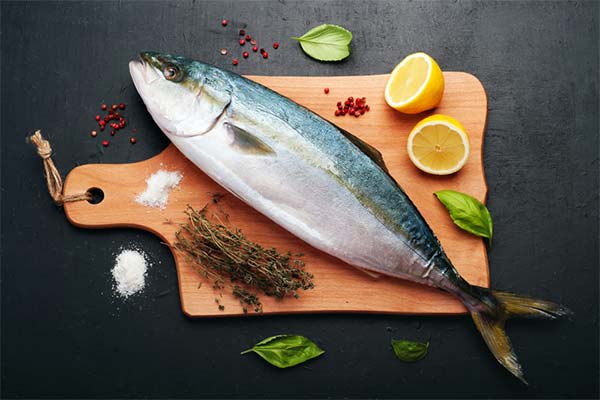
Japanese lakedra meat is salted, pickled, used to prepare a kind of sushi hamachi nigiri, a rich soup or fish soup, added to salads with seafood.
In the oven
A classic recipe for yellowtail baked in foil.
Product set:
- 0.5 kg of fish;
- 1 pc. onion;
- 0,5 lemon;
- 20 liters vegetable oil (preferably olive oil);
- spices, salt;
- several sprigs of fresh parsley.
How to bake:
- Cut off the fins with kitchen scissors, get rid of the scales. Cut off the head, gut the fish. Rinse carcass in running water, dry with paper towels.
- Mix salt and pepper. Rub the mixture into the skin, leaving no loose spots.
- Chop the herbs, cut the onion into large half rings. Mix both ingredients together, place in the belly. Wrap lakedra with string or sew up the belly.
- Turn on the preheated oven, setting the temperature to 180 degrees.
- Cut 4 circles from the lemon halves, dividing each one in half. Make 4 oblique incisions on the sides of the carcass. Insert the halves of the circles into them.
- Squeeze the juice from the rest of the citrus and mix with the oil. Brush all sides of the fish.
- Place a double sheet of foil in a baking dish, wrap the laked fish in it, carefully pinch the edges together.
- Bake for 20 minutes. Uncover the foil. Continue cooking the yellowtail for another 10 minutes, until the meat is browned.
Serve fish with mashed potatoes, rice, sour cream or cream sauce, with baked vegetables - young zucchini, carrots, bell peppers.
In a pan
To quickly, deliciously fry 500 g of lakedra fillets in a pan will need:
- 2 tbsp. each of frying oil and soy sauce;
- 20 ml honey;
- 3 garlic cloves;
- 1 tsp. mustard seed, ginger;
- 0.5 tsp. coriander;
- 2 eggs;
- 100 g of flour or potato starch for breading.
Preparation algorithm:
- In a bowl, mix the soy sauce, honey, coriander, and pepper. Add mustard, ginger. Squeeze garlic through a press.
- Mix the ingredients. Coat fillets with marinade on both sides, leave for a couple of hours.
- Beat eggs with a fork. Pour flour into a bowl. Dip the fillet in a bowl with eggs, then roll in breading. Fry on a hot pan with vegetable oil over medium heat for five minutes on each side.
Serve fried lakedra with greens, cucumber salad, tomatoes, sweet peppers or pickled cucumbers, cabbage.
In the multicooker
Useful, tasty steamed fish can be cooked quickly in the multicooker.
Ingredients:
- 0.5 kg of lakedra fillets;
- the juice of half a lemon;
- salt, pepper;
- 2-3 sprigs sprigs of dill.
Method of preparation:
- Pour 1.5 cups of water into the bowl of a multicooker.
- Place a basket on top of the bowl. Place herbs on the bottom.
- Cut the filet into portions. Season with salt and pepper and lemon juice.
- Place the prepared fish on top of the dill. Close the lid, set the steam mode, time - 15-20 minutes.
Spread steamed lakedrums on a salad leaf, serve with fresh cucumbers, tomatoes, bell peppers.
On the barbecue or grill
Yellowtail cooked with grilled vegetables is a stand-alone dish that does not require a side dish.
Prepare for grilling:
- 400 g fish fillets;
- Carrot, zucchini, sweet bell pepper, celery root, onion (1 piece each);
- 2 cloves garlic;
- 50 ml lemon juice, cooking oil;
- Sesame, pepper, salt, thyme.
How to prepare:
- Cut the fillets into pieces.
- Prepare the marinade. Combine in a bowl lemon juice, garlic, thyme, pepper, salt, mix.
- In half of the mixture marinade the fish.
- Slice vegetables into slices and grill.
- Fry marinaded fillets.
Serve ready fish with grilled vegetables, sprinkle with sesame seeds and pour the rest of marinade.
Recipe of yellowtail soup
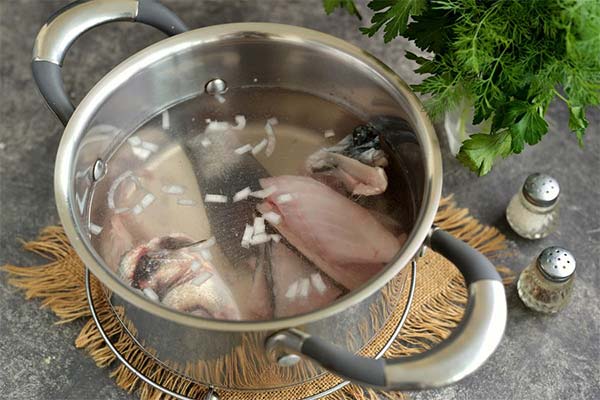
To cook fish soup at home with millet prepare the ingredients:
- head, trimmings lakedra;
- 1 onion, 1 carrot each;
- 4 potato tubers;
- 3 tablespoons of millet;
- two bay leaves;
- 6 peas of black pepper, salt;
- two sprigs of dill, parsley.
How to boil:
- Pour 2 liters of cold water over the tail, fins, head with the gills removed.
- Put the pot on the stove. After boiling, turn down the heat, simmer for 20 minutes.
- Slice peeled potatoes, carrots. Dice onions.
- Take pot off the stove. Remove fish, strain broth, and put back on fire.
- Add the grits. After 5 minutes of boiling add chopped vegetables. Continue to cook for a quarter of an hour.
- Five minutes before the end of cooking, salt the dish, add two bay leaves, and pepper.
Serve the soup, pre-sprinkling it with chopped parsley and dill greens.
How to salt seaweed
To salt a 500-gram carcass you will need 20 g of coarse salt, 40 g of sugar, 50 ml of vegetable oil, lemon, black pepper.
How to salt:
- Cut the fish into fillets. Cut off the head, cut off the fins with scissors, flatten the belly, remove the entrails and rinse. Helping yourself with a sharp knife, remove the skin. Make a deep incision along the back, remove the flesh from the backbone.
- Mix the seasonings in a bowl. Rub two halves of the fillet with the mixture on both sides. Cut the meat into 3 cm wide strips.
- Put fish pieces in a glass jar, pour oil over them. Place a lemon sliced into circles on top.
- Put the container with fish in the refrigerator.
After two days, salted yellowtail can be tasted.
Q&A
Russian consumers of lakedra are interested in the taste, fat content of the fish and how bony it is.
What does lakedra taste like?
The rich flavor with a pleasant aroma of Japanese yellowtail resembles a delicacy of tuna. The dense meat retains its shape when fried, braised, and baked.
Fatty or not?
Lakedra belongs to the fatty varieties. Its fat content is 16%, which does not prevent the inclusion of fish in the diet of athletes to build muscle mass.
Are there many bones in the fish?
The yellowtail skeleton consists of a strong backbone and side bones, easily extractable from the dense flesh. There are no small bones.
Interesting Facts
Facts of interest about the yellowtail:
- The Japanese consider the yellowtail, an invariable attribute of wedding ceremonies, a symbol of the groom's successful career and the bride's thriftiness.
- In Japanese Shinto shrines on the holiday Siti-go-san, a salted fish is given to worshippers to relieve illness and misfortune.
- The lakedra has several names depending on its age. In the eastern regions of Japan, they are wakashi, inada, and varasa. In the west, they are tsubasu, hpiachi, and mejiro. Examples with a length of 80 cm or more in all regions are called buryi.
Properly selected, deliciously cooked yellowtail delivers gastronomic pleasure, quickly recharges energy, maintains health, prolongs youth.
«Important: All information on this site is provided for informational purposes only purposes. Before applying any recommendations, consult a health care professional. specialist. Neither the editors nor the authors are liable for any possible harm caused by materials."

